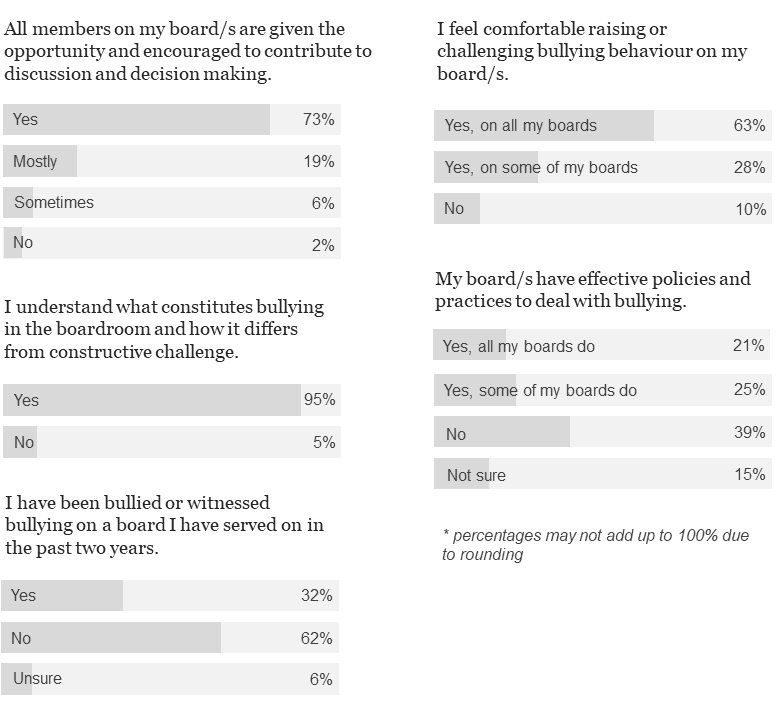What I’m reading – Stefan Speller
Director Stefan Speller shares why Patrick Lencioni’s leadership fable remains a go-to read for navigating dysfunction at the board table.

We recently ran a short pulse check with IoD members which sought to understand the extent that bullying impacted directors in New Zealand.
WorkSafe NZ defines bullying as “repeated and unreasonable behaviour directed towards a worker or group of workers [which] can lead to physical or psychological harm.”
We received 247 respondents to the pulse check. Ninety five percent indicated they knew what bullying in the boardroom looked like and how it was different from constructive challenge. A majority of respondents (73%) also felt that they were given adequate opportunity to contribute to discussion and decision making on their boards. Nineteen percent said they were usually given the same opportunities whilst six percent said they were only sometimes given opportunity to contribute. Two percent said they were not given any opportunity to contribute.
Almost one third of directors had witnessed bullying or had experienced bullying on one or more of the boards they have served on in the past two years. However, almost all respondents felt comfortable raising and challenging bullying behaviour – just over 90% were comfortable raising issues on all or some of the boards they currently sit on whilst 10% did not feel comfortable raising bullying behaviour on their board/s.
Boards could consider developing policies, codes of conduct or practices to address bullying. Although 46% of respondents were confident some or all of their boards had effective policies and practices to deal with poor boardroom behaviour, the remaining 54% indicated they either had no policies or practices in place or were unsure if these existed.
The poll was designed as a follow up to Feelin' alright by Matthew Boyd CFInstD which asks why the wellbeing of directors isn’t on the board agenda; and Bullying on boards - let’s talk about it by Craig Stobo CFInstD which aims to raise director consciousness of bullying at board level and notes that there is little research or data collected on boardroom behaviours.

We asked three IoD members for their perspectives on the pulse check.
Chair Ultrafast Fibre
Whilst many respondents indicated they had witnessed bullying or had been bullied, I doubt there would be a common understanding of what constitutes bullying in the boardroom. As such, we need to be very careful about using the term without defining it first. In my experience, bullying at board level could be best described as a director "playing the person, not the issue”.
"Being a director requires a lot of self-awareness. You need to be able to read people and read their reactions to you. To be effective on boards you need a coalition of support. If you are a lone wolf, you need to self-examine and try and understand whether you are out of step or whether you are being blocked. If you are being blocked assess the long game and the interests you are serving in order to make a decision about whether to tough it out or step down.
"Not all directors are elected. Some are appointed and some do not have the requisite skills or competencies to be in the role. I would advise against accepting a board role unless you are clear you have the skills the board needs and that you can contribute. The boardroom is not the place for training wheels; you need to come well prepared and ready to engage."
IoD Wellington branch committee member
"I think the definition of bullying as being a behaviour which is “repeated and unreasonable” rings true. But, the boardroom is a place of robust and challenging dialogue and we cannot shy away from conflict. Contrarian positions need to be presented objectively and without anger. It’s not only what you say, but how you say it that is important as well.
"We also need to be careful to understand the difference between diversity of thought, which is positive but may be perceived as conflict; and ‘group think’, which may be perceived as consensus and harmony, but may lead to inferior decision making and poor outcomes.
High functioning boards should not have directors who come to meetings with preconceived and immutable positions on items on the agenda. We need to recognise the importance of differing points of view but it is also important that boards reach consensus in order to move forward."
Strategic advisor to CEOs and company directors
"Whilst the poll sheds some interesting insights into director behaviour on boards, one area it could have also explored is unskilled behaviours in the relationship between the board and CEO.
"When board frustrations bubble over into blame, criticism and threat, the CEO becomes very isolated and can feel under attack. It is easy for a board that has a culture of blame to tip into bullying behaviours that are often hidden but quite unacceptable. In my role advising boards, I get a window into the negative consequences of these behaviours on individuals and this undoubtedly impacts the business more widely.
"A good board has a no-blame culture and understands that even the most experienced and capable leaders have learning and development needs that require support and investment. A good board is prepared to invest in its own and its CEO’s development.
"If boards do respond to the IoD poll by initiating or making changes to policies and codes of conduct I’d suggest that the scope of these is broadened beyond the board to include the board’s relationship with the CEO and executive."
"There is no reason to believe that bullying behaviour is any less common within the boardroom context than it is anywhere else in a business. In the 2020 report of the NZ Workplace Barometer data from Massey University's Healthy Work Group 11% of workers reported an experience of being bullied and 41% reported they had witnessed bullying in the workplace.
"A key focus of boards, executive and senior leaders, and managers must be to create a work environment that supports workers to stand up and report unacceptable behaviour without fear of recrimination. If a business prioritises the establishment of a positive workplace culture, where the health, safety and wellbeing of workers is paramount, workers feel more engaged, are more productive, and are more likely to be proactive in maintaining a positive and safe working environment.
"One of the key factors in the development of a positive workplace culture is effective leadership. That is, leaders who are informed and positively committed to the mental wellbeing of all workers. Effective leadership includes setting a good example, identifying champions/influences of positive mental health within their organisation, being pro-active in supporting positive mental health through the establishment of good work design initiatives, and supporting/resourcing positive action and activities. Good work is good for workers, good for business, and through the spillover effect it is good for the whole community."
WorkSafe provide tools and resources for businesses and workers to help prevent bullying in the workplace.
We would be interested in hearing from boards which do have specific policies and codes of conduct in place and how effective these are. Contact us